Viviane Menezes, Chief Scientist, and other WHOI folks are at sea on the R/V Revelle RR2303 to support the long-pandemic-delayed field programs for the Deep Madagascar Basin and East Madagascar Current Experiments. The DMB experiment aims to determine the pathways of Antarctic Bottom Water through fracture zones in the Southwest Indian Ridge and through the Madagascar Basin. To achieve these goals, we are occupying CTD stations and measuring surface to bottom currents (LADCP), sampling nutrients, oxygen and CFC-SF6 tracers, deploying deep SOLO floats, and isobaric RAFOS floats ballasted for 3000-dbar. The EMC experiment aims to better understand the fate of the surface intensified East Madagascar Current as it flows south along the east side of Madagascar, and how it bifurcates at the southern end of Madagascar, by following the flow at three levels: surface via drifters, and at two density surfaces at about 300-m and 600-m using isopycnal RAFOS floats.
Students from countries surrounding the southwest Indian Ocean are onboard, including Madagascar, South Africa, Reunion Island, Mozambique, Namibia, and also Brazil and the UK. Pictured is Viviane leading the late-night deployment of a Deep SOLO float, which will be piloted by Pelle Robbins of the WHOI Argo group. Other WHOI folks onboard include Frank Bahr leading the LADCP and SADCP data collection, Anne Cruz supporting CFC/SF6 sampling, Andy Davies leading the mooring deployments, Heather Furey as co-Chief Scientist, and Lab Assistant Alexis Mullen helping with CTD data collection, sampling, and float deployments.
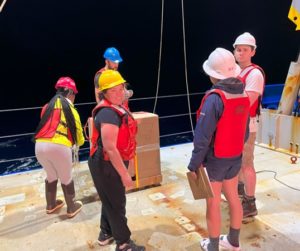
Viviane Menezes, Chief Scientist, leads the late-night deployment of a Deep SOLO float, which will be piloted by Pelle Robbins of the WHOI Argo group. (Photo provided by Frank Bahr)
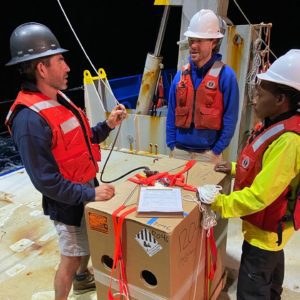
Andy Davies, ResTech Nick Benz, and student Gesica Canivete from the Higher Institute of Science and Technology of Mozambique/Maputo Port Development Company prepare to deploy a Deep SOLO float at the Atlantis II Fracture Zone as part of the Deep Madagascar Basin Experiment cruise RR2303 April-May 2023. (Photo provided by Heather Furey)
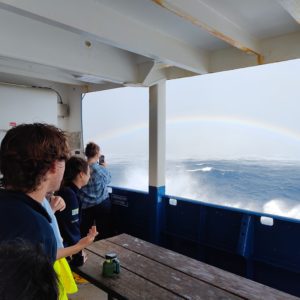
‘Rainbow Alert!’ Heather Furey snaps a pic aboard the R/V Revelle while crossing the Mozambique Plateau during an autumn storm, as part of the Deep Madagascar Basin cruise RR2303 April-May 2023. (Photo provided by Nick Matthews)
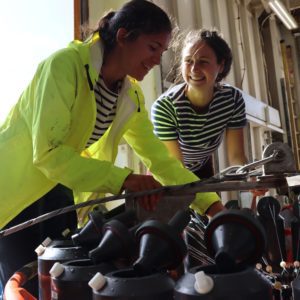
Students Oceane Desbonnes (left, L’Agence de Recherche de la Biodiversité de La Reunion) and Lizzie Ellison (right, Imperial College) work on prepping the rosette for the next CTD cast, onboard the R/V Revelle as part of the Deep Madagascar Basin cruise RR2303 April-May 2023. (Photo provided by Heather Furey)
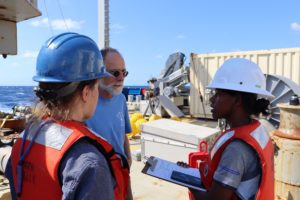
Heather Furey and Frank Bahr discuss an upcoming mooring deployment with student Vatosoa Raheriarilala (University of Toliara, Madagascar Institut Halieuticque et des Science Marine), onboard the R/V Revelle as part of the Deep Madagascar Basin cruise RR2303 April-May 2023. (Photo provided by Rouane Brokensha)
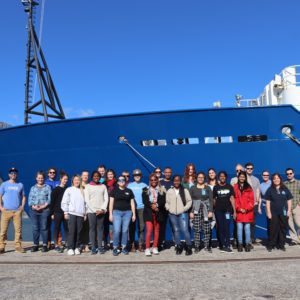
The science party for the Deep Madagascar Basin Experiment, led by Chief Scientist Viviane Menezes and joined by WHOI PO personnel Heather Furey, Andy Davies, Frank Bahr, in Cape Town prior to departure on the R/V Revelle cruise RR2303 April-May 2023. (Photo by Nick Matthews)
